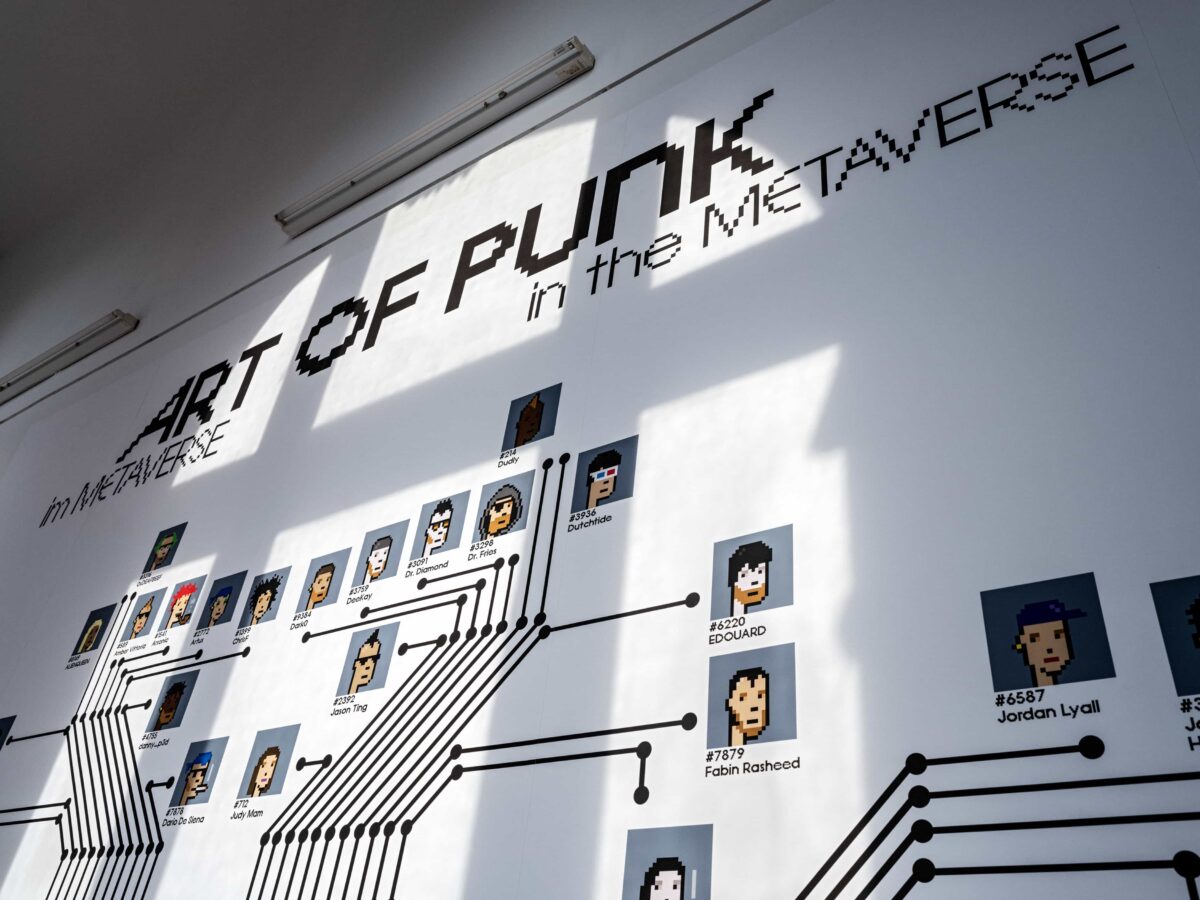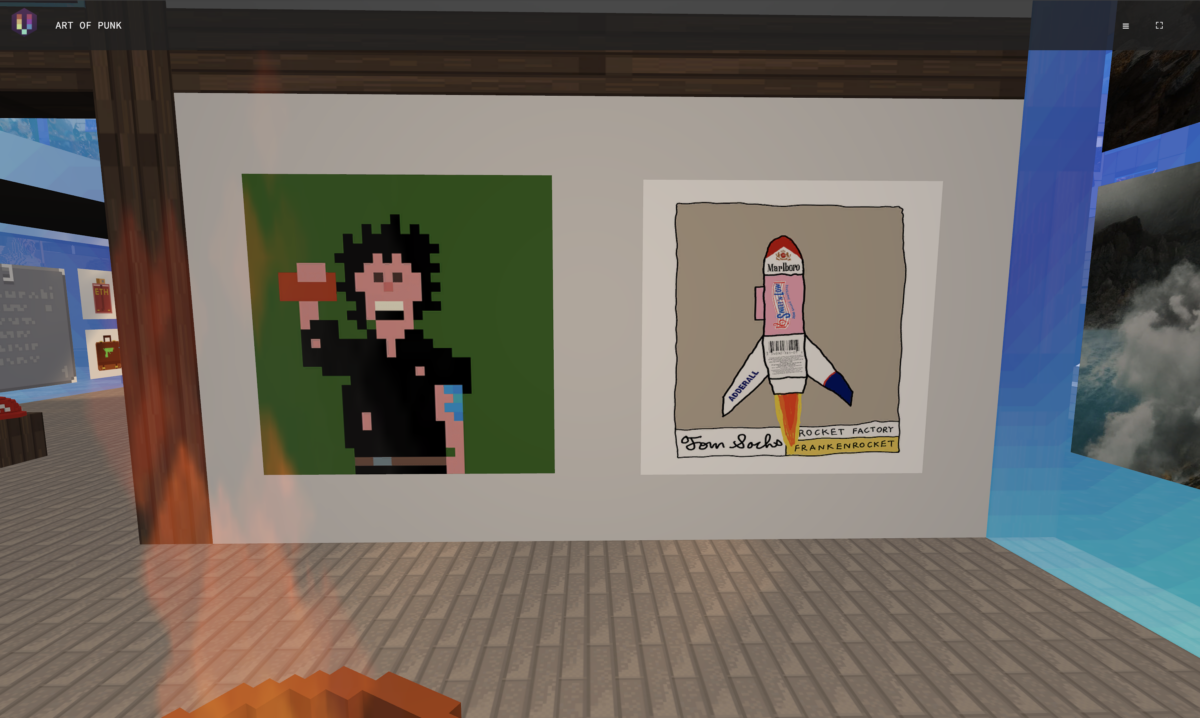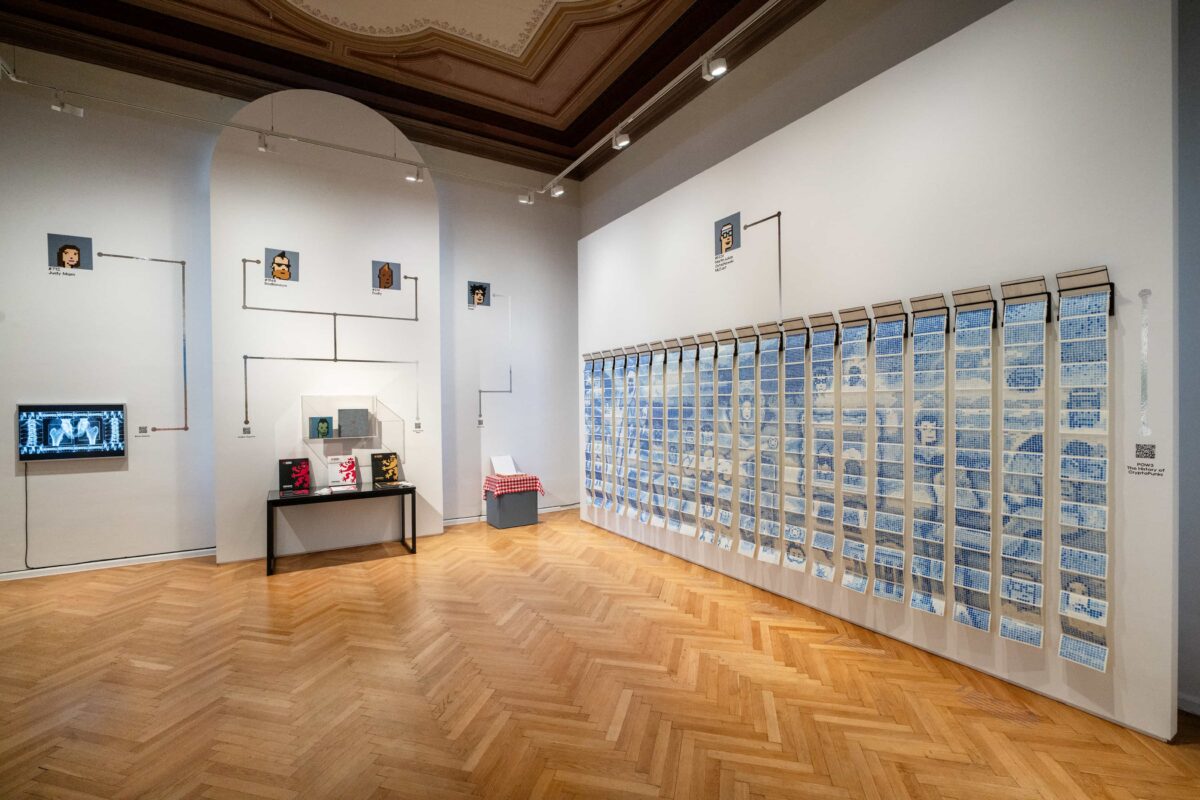As 2025 kicks off, there are only five days left to view one of the most significant Web3 art exhibitions launched in 2024: the “ART OF PUNK” exhibition, showing simultaneously at the Museum Francisco Carolinum in Linz, Austria, and within the Voxels metaverse.
Curated by renowned OG CryptoPunk holder Julia Staudach (known in the community as @tschuuuuly), the exhibition is made up entirely of works created by CryptoPunk holders, ranging from traditional physical paintings to innovative digital and on-chain creations.
The Francisco Carolinum has a strong track record with NFT collections. It was the first museum with an exhibition of NFTs, delving into their history in 2021, and its city of Linz is the home of Ars Electronica, an annual new media festival.
While some “ART OF PUNK” pieces are from well-known creators, others are from emerging artists. The exhibition, which launched in September 2024, offers visitors a glimpse of the human connectivity and potential that is unlocked when one joins an NFT community like CryptoPunks.
The exhibition comes at a time when the bridge-building potential of NFTs, and particularly CryptoPunks, has also been highlighted by “Free to Claim,” the gargantuan Phaidon Press book that offers a comprehensive history and catalog of the CryptoPunks collection.
The Living Punk Community
To convey the experience of a living community in a book, or an exhibition, poses a challenge.
“Free to Claim” captures the role that human connection has played in the Punk story by pushing the boundaries of what is possible in a physical text—for example, including excerpts of Discord chats, or publishing detachable images of every Punk token on blotter paper, evoking LSD.
Similarly, the “ART OF PUNK” exhibition captures the community essence in its own medium-blurring way. In addition to the expected ways of identifying artworks in an exhibition—a card listing title and creator—each piece in the Linz exhibition is linked, with a visual line evoking a circuit on a chip, to an image of the particular Punk which that creator uses as their digital identity.
The Museum has commissioned a video tour of the Linz part of the exhibition that gives a sense of its depth and variety, and there is a wealth of artwork to explore. Equally important is the metaversal aspect of “ART OF PUNK”; far from being haphazard, the Francisco Carolinum considers its base in Voxels an equal part of its presence, and the metaverse branch of the Museum has been a pioneer in holding virtual exhibitions since its launch in 2021. Many of the finest works in “ART OF PUNK” can only be seen in the Digital Francisco Carolinum.
Along with breakout, globally recognized luminaries like Mike Winkelmann (beeple), Pindar Van Arman, Claire Silver, Matt Hall and John Wilkinson of Larva Labs, Tom Sachs, Kevin Abosch, and 0xdeafbeef and Nina Chanel Abney, the exhibition also shows works from Punk-holding creators who are mostly known in the Web3 community. Some are established, like Twin Flames photographer Justin Aversano, multimedia artist and historian Martin Lukas Ostachowski (MLO), and serial NFT project founder natealex. Still others are just now dipping their toes into the world of art.
The exhibition is on for just a few more days; it is open, in its Linz, Austria, and Voxels locations, until Jan. 26.

Art Is More Important Than Ever
In a space where so much of human experience has become swept up in market forces, creativity and community for their own sake, as highlighted in “ART OF PUNK”, become even more important. This notion is thrown into sharp relief by current events; in the last few weeks, rumors about a possible sale of Punk IP by Yuga Labs, touched off by the X-based crypto writer known as Wale, sparked a high-volume CryptoPunk trading frenzy and floor price rally.
Against the backdrop of the crypto market’s optimism about a favorable regulatory environment under the new administration, on Jan. 17 President Trump released a $TRUMP memecoin on Solana, driving much of the crypto space’s liquidity into the coin, which quickly peaked at an all-time-high market cap of $33B.
We have a lot of people really digging deeper into the matter, really trying to understand it. And as far as I can say, the quality of art is pretty amazing.
Julia Staudach, curator of “ART OF PUNK”
The euphoria of memecoins and the uncertainty of rumor-fuelled trades are a sharp contrast to the steady, focused work of artistic creation. Pindar Van Arman’s virtual creativity or the magical, emotionally affective visual fairytales of Claire Silver are the result of many years of often-frustrating practice. Pindar’s painstaking work of building robots and training algorithms, and Claire’s countless hours honing aesthetics and sharpening prompts across thousands of generations, must seem utterly alien to those whose focus is the few minutes, hours, and days after the release of a memecoin. But when the dust settles, when the Crypto Balls and conference side parties are a memory, when we can barely remember the name of last month’s biggest memecoin, Punks will remain, and art—and artists—will remain.
nft now spoke to curator Julia Staudach (tschuuuly) about the exhibition.
lorepunk: The first question that I have is why? Some random person who isn’t familiar with Punks would probably ask this question—why have an art exhibition based on whether people hold a specific token, instead of something else, like medium, format, theme, or all the other things that people usually have art exhibitions about?
tschuuuly: In the case of the CryptoPunk community, there’s really a high number of artists among that community. Being part of the community, and knowing many of them, I pretty early on had the idea that it would be cool to have an exhibition that features people from that community because there’s such a high number of high-quality artists.
So since I started as a curator [at Francisco Carolinum] one year ago, now I have gotten the chance to do it, and I’m simply doing it.
“ART OF PUNK” is the first museum show that I’m curating alone, on my own, with no co-curator, with so many years on board. It’s just incredibly lots of work and coordinating, writing all the texts and descriptions, and planning. There are more than 80 people in the show altogether, in the metaverse and physical exhibition combined. So that’s quite a huge number of people.
How are your colleagues from more traditional art feeling about your selections and the exhibition in general?
I am so grateful to be working with such a cool team. They’re all very open to new forms of art and also to media art in general. They trust a lot in my expertise and my knowledge.
There was such a high number of high-quality entries—people sending in really cool art. So it was a hard choice to make because it was more than 100 people sending art. In the end, I ended up putting almost 90 people in the show. So, it was intense. And my colleagues trusted me, and they think it’s cool, what I’m doing, and support me in any way they can.
I think that the trust offered by the head of the museum, Alfred Weidinger, and everybody in his team is worth a lot, because, you know, I am a newcomer in this field of traditional art and museum curation. I was an artist myself, before, so I don’t have a big history of curating shows.
Colleagues said that curating a group show is the most complicated and most work-intensive way to curate a show; having one or two artists, that’s not that hard to do, but having a show with this many artists is quite a bunch of work, and I think they have been impressed by what I have accomplished.

This exhibition can be experienced both in Linz and in the metaverse. How are the two parts of the exhibition different?
The only piece that appears in the physical exhibition as well as in the metaverse is a rocket by Tom Sachs from his Rocket Factory project—“Clarice Starling,” which exists as an NFT and as a physical piece and is represented in both of the exhibitions.
But for the rest of the artworks, it’s different. I have some NFTs on display in the physical exhibition on screens, but mostly it’s prints, paintings, sculptures, poetry, music, videos, stuff like that. And most of the NFTs are shown in the metaverse, with a few on display in the physical show.
Physical exhibitions offer the chance for a special kind of interactivity; what are some of your highlights for the physical part of “ART OF PUNK?”
One big part of the project was adapting works that already existed for the exhibition. For example, 0xdeafbeef made this installation of a payphone, where people submitted messages via the blockchain that would make a phone ring.
He would pick up the phone, a computer voice would read those blockchain-submitted messages to him, and he interpreted it as an artwork. So for this exhibition, we have an installation with a phone, a rotary phone, and a monitor, you see the video that displays the various ways that 0xdeafbeef interpreted these blockchain messages earlier during his performance, and when picking up the receiver you can also hear the audio.
Another interactive piece is by Sarah Ridgley; she usually carries with her a tiny thermal print machine, from which she then generates, on her phone, from an app that she wrote, a “blind date” in the form of a generative poem.
Usually, when you meet her, you get a poem of the actual date and time of the moment when you met her.
But since she can’t be in Linz, in the exhibition all the time, we have a printer there, and you can print a blind date, and it will give you, in the style of her generative poems, a blind date in the near or middle near future—but not with Sarah—with your own future self. So visitors of the exhibition can take home their very own Sarah Ridgley-generated poems which are future dates with yourself.
Another lovely piece is a physical lifesize pixelated CryptoWiener Punk sitting on a bench, where visitors can take selfies with him.
Also, we have a lot of pioneer projects, like the Rare Pizzas, where, actually, I didn’t even count or name how many CryptoPunk holding artists contributed to this one!
And Eric Calderon, we know him under the name Snowfro, is in the exhibition with a Chromie Squiggle. Who is early? I think MLO is pretty early. And he’s telling the history of CryptoPunks in a huge piece with 21 notebooks that are hanging on the wall. And took various kinds of blue tones, in a mosaic pattern, and stamped them all over those notebooks hanging next to each other on the wall. 45,600 manually placed stampings, telling the history of the Punks, and showing the story of Matt Hall and John Wilkinson. The mosaic traces how they came from their early Android days, their games, to the birth of the CryptoPunks and later the v1 Punk controversy, Meebits, and the Yuga Labs sale, pretty much up until today.

How do you represent the metaverse half of the show in the meatspace half?
There is one huge wallpaper in a connecting aisle that shows all the Punks that are represented in the metaverse—they don’t see the artworks, but they see the Punk heads and numbers, and the artists’ names. And then there’s a QR code—you can simply scan it, and then you immediately jump, with your phone, into Voxels.
I am curious how this ecosystem of crypto craziness and art will develop in the next years, but I am sure CryptoPunk holders will play a big role.
Julia Staudach
Zooming out even further, many Punks are in creative fields like music or cinema. Can you tell us about how you’ve included them in the exhibition?
Since there are not only Punk-holding artists who work with either NFTs or physical works that you can touch and hang on the wall but there are also many Punks who are filmmakers, producers, or musicians producing music videos, I wanted to do something special.
So since there are so many works that are actually movies or videos, I hired the cinema theater which is a five-minute walk from the museum, for two dates. The first showing was on the fourth of September, one day after the opening event.
@Sherone33 has been working on a documentary, “CryptoPunks Origins.” I showed his extended trailer. I also showed “What the Punk,” the documentary by Martin del Pierre, who is not a Punk holder, but I thought would be worth showing anyway.
And of course, “Calladita” by Miguel Faus, who is a Punk holder too. Quite a bunch of shorts and trailers. The music videos of 8TARI and Asia Nikolaeva, who is a director from Ukraine. Also a short by Beeple and another one by Tom Sachs, also a making of Deekays I<3 Korea, and some NFT project trailers. So we have had quite a big movie program, which was on display in the cinema on the fourth of September and on the 16th of January.
I look at the “ART OF PUNK” description on the CryptoPunks hub, and it explains that the exhibition highlights insights into the creative dynamics of our community of Punks, which is operating at the intersection of art and technology. Is there anything that you learned about the creative dynamics of our community, or the Punks community as a whole, curating this show?
The first thing that struck me is that there are so many various kinds of art that are made by Punk holders. We have a couple of artists who have been artists before, already working physically or digitally, and there are also a lot of people who developed an impulse to make art when they got into Punks; they were, perhaps, inspired by CryptoPunks. We have a handful of artworks that are directly, visibly inspired by CryptoPunks themselves, or by the whole blockchain and NFT field. But we also have a lot of artworks that have nothing to do with Punks and are simply the creations of the artist: an artist who is proud to be a Punk holder, but whose artworks themselves are not directly inspired by the Punk collection. So we have a very big mixture here.
But what I noticed is that we have a high number of people in the community that dig deeper and try to make a little bit more out of it, like @0xdeafbeef with his on-chain art, or Gordon Berger with his AI train tags; not only has he inscribed the art on Bitcoin, but also inscribed/scratched in plaster.
Physically, we have a lot of people really digging deeper into the matter, really trying to understand it. And as far as I can say, the quality of art is pretty amazing. It may be dumb to say it like this, but we’re a very creative community, absolutely.
I’m super honored and grateful to have the job I have—like, I was headhunted to do this, to be the curator for the DFC—the digital Francisco Carolinum, which has existed since 2021; I’m super grateful to have this great opportunity and the trust they provide to do this.
I’m so grateful also for all the Punks helping to make this happen by sending their art!
Some people brought their physical art themselves by car! @PIV_PIV brought his artworks by car from Belgium, drove all night, and drove back the next day. He brought his physical pieces and also a couple of bottles of Belgian beer, which I highly appreciate.
Punks came to DJ the opening night without asking for any compensation. They came. They paid for the travel. They paid for the hotel rooms themselves. They DJed. They brought their equipment, brought people out, and activated people spreading the word. There are so many people who have been helping to make this great, and I didn’t even ask for that, you know, that’s just really people asking me, “Hey, how can I help?” And the appreciation I’ve been getting is incredible and helps me go through all these weeks of almost no sleep and intense work; the thanks are amazing.
I am curious how this ecosystem of crypto craziness and art will develop in the next years, but I am sure CryptoPunk holders will play a big role.
Editor’s note: Lorepunk is a CryptoPunk holder, and exhibited two poems as part of ART OF PUNK.
The post Art of Punk: Inside the CryptoPunks Artist Group Show in Austria appeared first on nft now.


 The show is on view until January 26!
The show is on view until January 26! Francisco Carolinum Linz, UNESCO City of Media Arts
Francisco Carolinum Linz, UNESCO City of Media Arts 
 Read more about ‘AI Chain Tags’ here: https://t.co/kHNVyfBpLZ
Read more about ‘AI Chain Tags’ here: https://t.co/kHNVyfBpLZ